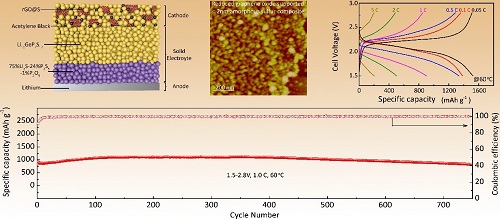
Lithium-sulfur batteries are considered as one of the most promising next-generation high-energy-density energy storage devices. The theoretical specific capacity and specific energy of elemental sulfur in positive electrode materials can be as high as 1675 mAh/g and 2567 Wh/kg, which are currently commercial lithium. Five times the positive transition metal oxide. However, the poor safety and cycle performance of traditional lithium-sulfur batteries are the main challenges they face, which seriously affect the commercialization process. The solid-state lithium-sulfur battery using an inorganic solid electrolyte instead of a conventional organic electrolyte can effectively suppress the generation of polysulfide, thereby eliminating its shuttle effect and greatly improving its safety. It is an important direction for the development of lithium-sulfur batteries in the future.
Although all-solid-state lithium sulfur can solve the problems currently faced by conventional lithium-sulfur batteries, it brings new challenges, such as solid-solid interface problems and the effects of stress/strain and other effects on battery capacity attenuation, which affect all-solid-state lithium. The key to the cycle life of sulfur batteries. Recently, the team led by Yao Xiayin, researcher of the Solid State Lithium Battery Team of the Ningbo Institute of Materials and Engineering, Chinese Academy of Sciences, and the University of Maryland in the United States have designed a new type of all-solid-state lithium-sulfur battery with a sulfur positive structure, which is ultrathin deposited on the reduced graphene oxide. The (~2 nm) amorphous nano-sulfur layer maintains the high electron conductivity of the composite, and thus the reduced graphene oxide/sulfur composite is evenly dispersed in the lithium-ion-conductor Li10GeP2S12 based composite material, thereby achieving high ionic conductivity and Low stress/strain. The above-mentioned reduced graphene oxide/sulfur composite-Li10GeP2S12-acetylene black mixture is used as a positive electrode layer, Li10GeP2S12/modified Li3PS4 double layer electrolyte is used as a solid electrolyte layer, and metal lithium is a negative electrode assembled all-solid-state lithium-sulfur battery. Its charge-discharge curve and tradition Lithium-sulfur batteries are very different, with only one pair of charge and discharge platforms, which significantly inhibits polysulfide production.
At 60°C, the initial discharge capacity of 0.05C was 1629 mAh/g and the first Coulomb efficiency reached 90%. At the same time, it showed excellent rate performance, and was charged and discharged at 0.1C, 1.0C, and 2.0C at different magnifications, exerting 1384.5, Reversible capacity of 903.2 and 502.6 mAh/g; 1.0 C large rate Reversible capacity of 830 mAh/g can still be maintained after 750 cycles of long-cycle charge and discharge, and the single-cycle capacity decay rate of the battery is only 0.015%. The traditional lithium-sulfur battery significantly improves the cycle performance.
Related work was published in Advanced Energy Materials (2017, doi: 10.1002/aenm. 201602923).
The above research work was supported by projects such as the Nano-precursor Project of the Chinese Academy of Sciences (XDA09010201), the National Natural Science Foundation of China (51502317), and the Youth Promotion Association of the Chinese Academy of Sciences (2017342).
Special production is available for other drawer slide systems slide lengths
Furniture Drawer Slide,Drawer Slides Rail,Drawer Rails Slides,Ball Bearing Drawer Slides
ChongQing Troya Hardware Manufacture Co., Ltd , https://www.cqtroya.com